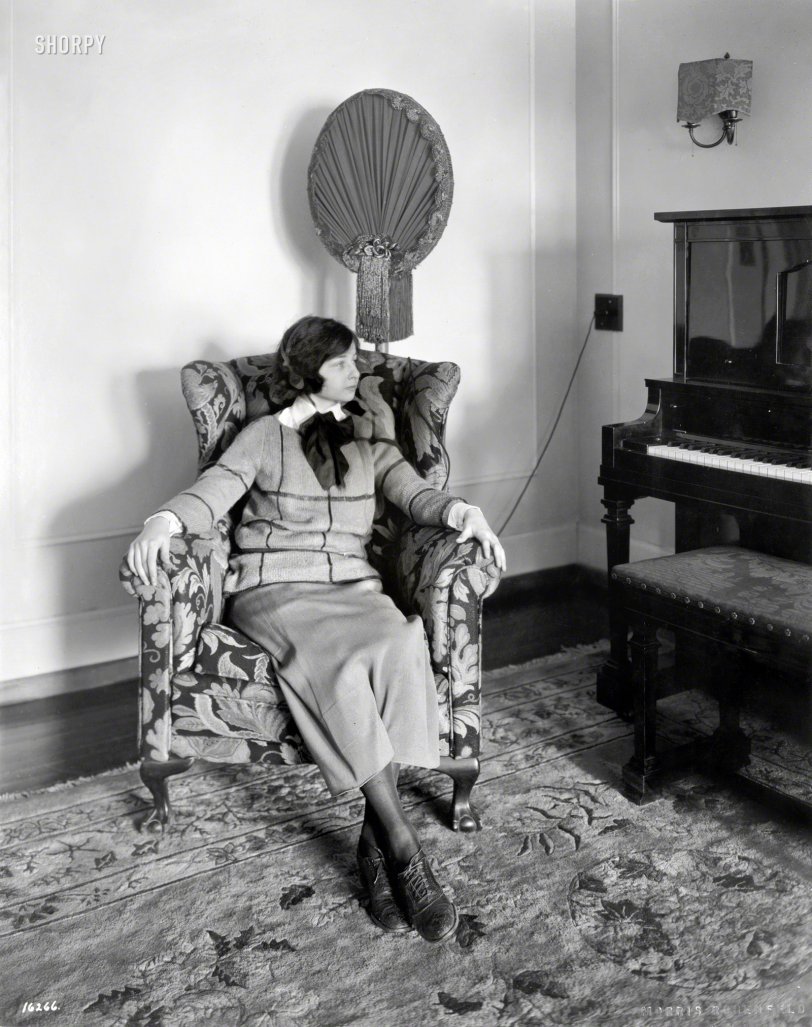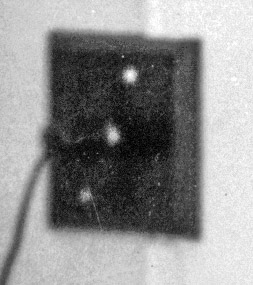


Framed or unframed, desk size to sofa size, printed by us in Arizona and Alabama since 2007. Explore now.
Shorpy is funded by you. Patreon contributors get an ad-free experience.
Learn more.

- Freeze Frame
- Texas Flyer wanted
- Just a Year Too Soon
- WWII -- Replacing men with women at the railroad crossing.
- Yes, Icing
- You kids drive me nuts!
- NOT An Easy Job
- I wonder
- Just add window boxes
- Icing Platform?
- Indiana Harbor Belt abides
- Freezing haze
- Corrections (for those who care)
- C&NW at Nelson
- Fallen Flags
- A dangerous job made worse
- Water Stop
- Passenger trains have right of way over freights?
- Coal
- Never ceases to amaze me.
- Still chuggin' (in model form)
- Great shot
- Westerly Breeze
- For the men, a trapeze
- Tickled
- Sense of loneliness ...
- 2 cents
- Charm City
- What an Outrage
- Brighton Park
Print Emporium
Hooked Up: 1923

New York, 1923. "Miss Sylvia B. Fisch listening in to a radio program." Photo by Morris Rosenfeld. View full size.
Some ideas on the technology (and Sylvia)
I discussed this with some of the members of the local antique radio club. Of course you never get a straight answer on something like this, but the consensus (more or less) is that she was listening to a radio (probably a TRF [tuned radio frequency] or regenerative set) which was located somewhere else in the house, with jacks that could be used to listen in various rooms. By 1923 tube radios and amplifiers were available that could send sufficient volume to use earphones at the room jack.
The thing behind her chair is probably a horn speaker to use when more than one person wants to listen. The box under the "bubble" might be an amplifier to get sufficient volume for the speaker. The amplifier would be plugged in to the jack instead of the earphones.
I'm not sure why anyone would take a photo like this except as an example of "conspicuous consumption," since this would be very advanced stuff for 1923 (superheterodyne radios didn't become commercially available until 1924). Is there any possibility the date is wrong?
Personally. based on my experience with 1920s radios, although nothing as old as 1923, having the radio in another room wouldn't be very practical since a lot of "fiddling" was involved to find and keep a good signal.
The only thing we all agreed on is that Sylvia is a cutie.
Just an educated guess.
I agree with the idea of the dressy fabric covering an antenna. It may also be housing the radio at the lower part being that a crystal radio's largest part is the tuning coil that is about the size of a toilet paper core.
I think the wall connection may be only an earth ground. The 1924 house I grew up in had a special outlet plate on both first and second floors. These had an antenna jack that went to the attic for a roof perimeter wire, and a ground jack that went to a grounding rod beneath the foundation. I built an AM crystal radio in the early 70's and these connections served me well!
Wall Plug
If the radio is behind the chair, the cord going to the wall is most likely not a power cord. Pre 1928 radios used batteries. The rectifier tube used to convert AC to DC didn't become available until then.
It could be a crystal set plus antenna but that wouldn't require a wire going to the wall at all.
I'm wondering if the radio is in another room and the plate on the wall is audio output to be used with headphones or a speaker, depending on which the listener preferred.

Possible explanation of "pole thing"
I believe that the "pole thing" is most likely a loop antenna, which was commonly used back then, and the cover is just to conceal it and attempt to blend it in with the surroundings or at least make it less jarring. The antenna probably swiveled for best reception as loop antennas are directional. As a Ham Radio operator for many years, I am quite used to attempts to disguise such objects.
I also believe that the radio set itself is behind the chair on the floor and that is where it hooks up to the antenna and the headphones. The cord coming from the wall is a power cord.
Fisch v. Fisch
Before the Roaring Twenties were out, Miss Fisch would hold half of her late father's estate, even during the life of her mother. Sylvia was one of two children of Newark hatter Joseph Fisch and his wife and business partner Fannie Fisch.
In December 1927 Joseph dropped dead of a heart attack while at work. His will provided that his estate should first go to his wife, but as the New Jersey Chancery Court would later explain in 1929, his widow declined to take the provision for her nominated in his will. Sylvia then petitioned to compel the executors to turn over to her and to her brother the corpus of the estate. Sylvia and her brother succeeded (subject to the widow's right of dower).
Soon thereafter, Sylvia married Charles Stamler, and later, New York department store magnate and philanthropist Leonard Ginsberg, surviving the latter at the time of his death in 1971.
Loop antenna
which was and is a fairly common style,
Looks to me like the radio is behind the chair, and loop is decorated to look better in the room.
https://www.radiolaguy.com/Showcase/Battery-20s/Deforest_Loop%20Antenna....
Shows one style of loop, various types had more or less loops, stacked in a column or spread as in the one linked.
Crystal Set?
It's possible it's a crystal set, which chiefly would require a big antenna and ground. If there's only one station, that would be what she's hearing.
A crystal set would require headphones because it produces little audio power.
Speaker of the House
What is the ornate item on a stand behind this lady? Could it be a loudspeaker?
[Or an antenna. - Dave]
And now for a musical epiphany moment ...
Putting on headphones and staring off into space is not just a 21st century concept, created by children who want to ignore their parents. People have been detaching themselves from reality for over a century.
Subdued Lighting
I am guessing the contraption directly behind Miss Fisch is a light (following the plugin) bulb covered by coloured material to diffuse and mellow the immediate area.
I always wondered as I have seen this kind of covering for most of my early life and always wondered why? why this didn't start a fire, or, how many fires were produced by this Fad?
Then again, this contraption may be something totally different.
























On Shorpy:
Today’s Top 5